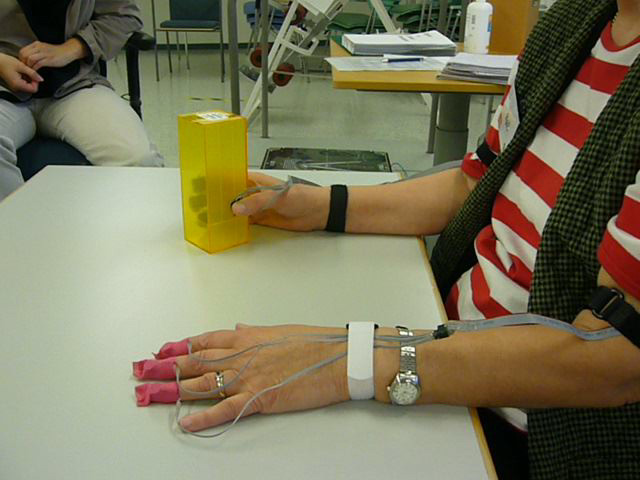new web: http://bdml.stanford.edu/pmwiki
TWiki > Haptics Web>StanfordHaptics > TampereStanfordPortableHapticsProject > TauchiRehabilitationProject>PortableLowCostHapticForMultipleSclerosis (06 Dec 2007, LiJiang? )
Haptics Web>StanfordHaptics > TampereStanfordPortableHapticsProject > TauchiRehabilitationProject>PortableLowCostHapticForMultipleSclerosis (06 Dec 2007, LiJiang? )
Portable Low-cost Haptic For Multiple SclerosisWelcome to the Stanford Biomimetics and Dexterous Manipulation Lab. This page describes a portable low-cost haptic feedback device designed for multiple sclerosis patients. Student working on this project: Li Jiang Topics on this homepage: Additional navigation links can be found in the left menu bar. |

|
Project Overview
Multiple sclerosis (MS) is an inflammatory disease of the human brain and spinal cord characterized by loss of myelin and axons in the nerve tracts. It is the most common cause of neurological disability affecting young adults in the United States and Northern and Central Europe. The numerous symptoms and signs of the disease include motor and sensory dysfunction of the hand and arm. This dysfunction is often asymmetrically distributed between the left and right upper extremity.The clinical picture differs in severity from one patient to another, yielding individual combinations of reduced modes of sensation, reduced muscle power and increased muscle tone. Sensory disturbances of the upper extremities are usually related to lesions in the posterior columns of the cervical spinal cord (typically loss of proprioception) but they may also be due to cortical pathology of the brain. Disorder of the autonomic nervous system is relatively common but the peripheral nervous system is usually spared. The ultimate goal of our study is to ascertain if rehabilitation of the affected hand is enhanced by providing haptic stimulation, initially to the opposite, less affected hand. Our intention is to utilize the plasticity of brain to compensate for central nervous system damage that is a primary mechanism of functional recovery in MS. Since the same phenomenon occurs in other important diseases of the central nervous system such as brain injury and stroke, the results may be of wide importance in neurological rehabilitation of hand and arm function. Although evidence of lasting rehabilitation must await further testing, we are able to show an immediate improvement in object handling forces when subjects are provided with vibrational haptic feedback based on measured fingertip forces.Details
* ThePortableLowcostHapticDevice * ForceSensorDesign * ExperimentProcedure * ExperimentResults * ConclusionSIdeas, requests, problems regarding TWiki? Send feedback